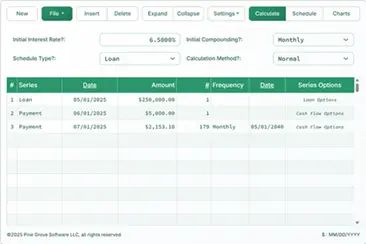How to Calculate Return on an Investment for "X" Days
To set your preferred currency and date format, click the “$ : MM/DD/YYYY” link in the lower-right corner of any calculator.
A Step-by-Step Tutorial
Tutorial 24
Sometimes it is necessary to calculate the return on an investment for a specific number of days.
For example, if you invest in money market funds or certificates of deposit (CDs), the term may be measured in days. Even when trading long-term bonds, you may need to calculate the accrued interest since the last coupon date. Accrued interest is considered the return on the investment. The Ultimate Financial Calculator can calculate the return over a defined number of days. This tutorial shows how to perform that calculation.
In this example, you need to calculate the return for a fixed number of days, but you do not know the future value date. In other words, you want to calculate the interest earned over 92 days, but you are unsure of the date that is 92 days after the investment begins. Step 4 explains how to calculate that future value (FV) date. If you already know the FV date, you can skip Steps 4D and 4E and enter 1 for frequency.
All users should work through the more detailed first tutorial to understand the UFC’s basic concepts and settings.
To calculate the return for a specific number of days, follow these steps:
- Set Schedule Type to “Savings”.
- Or click the button to clear any previous entries.
- Set Rounding to “Open balance—no adjustment”.
Select . - Set initial values for the investment cash flow in the header section.
- You can change both the interest rate and the compounding method on later dates (see Tutorial 4).
- Enter 5.3 for Initial Interest Rate (5.3%).
- Set Initial Compounding to “Daily”.
- Set Calculation Method to “Normal”.
- Click on row one of the cash flow grid. Fig. 1
- Set the Series to “Deposit”.
- Set the Date to 11/24/2024 (mm/dd/yyyy).
- Set the Amount to $28,500.00.
- Set # Periods to 92.
- Set Frequency to “Daily”.
- The date 92 days from the start date will be February 23, 2025.
- This date is calculated automatically by the calculator.

- Create a “Withdrawal” series in row two. We will complete it in the next step. Fig. 2
- Assume this example calculates accrued interest for a bond.
- Bonds usually compound interest on a semiannual basis.
- Change Initial Compounding to “Semiannually”.
- Change # Periods in row one to 1.

- Set the details of the “Withdrawal” series in row two:
- The Date should already be set to 02/24/2025.
- Step 4 calculates the last of the 92 days as February 23, 2025. However, we need 92 full twenty-four-hour periods, which ends on February 24.
For example, if an investment starts on November 24 and you withdraw the funds on November 25, that is only one full day. To earn interest for two full days, the withdrawal must occur on November 26. This same principle applies here.
- Step 4 calculates the last of the 92 days as February 23, 2025. However, we need 92 full twenty-four-hour periods, which ends on February 24.
- Set the Amount to “Unknown” by typing U.
- Set # Periods to 1. Fig. 3
- The Date should already be set to 02/24/2025.
- We are now ready to calculate the unknown value. Your screen should look like this:

- Calculate:
- Result: $28,880.73. Fig. 4
- Click the button to view interest earned: $380.73

The return on an investment of $28,500.00 over 92 days at an interest rate of 5.3%, using semiannual compounding, is $380.73.
Back to the Ultimate Financial Calculator.
